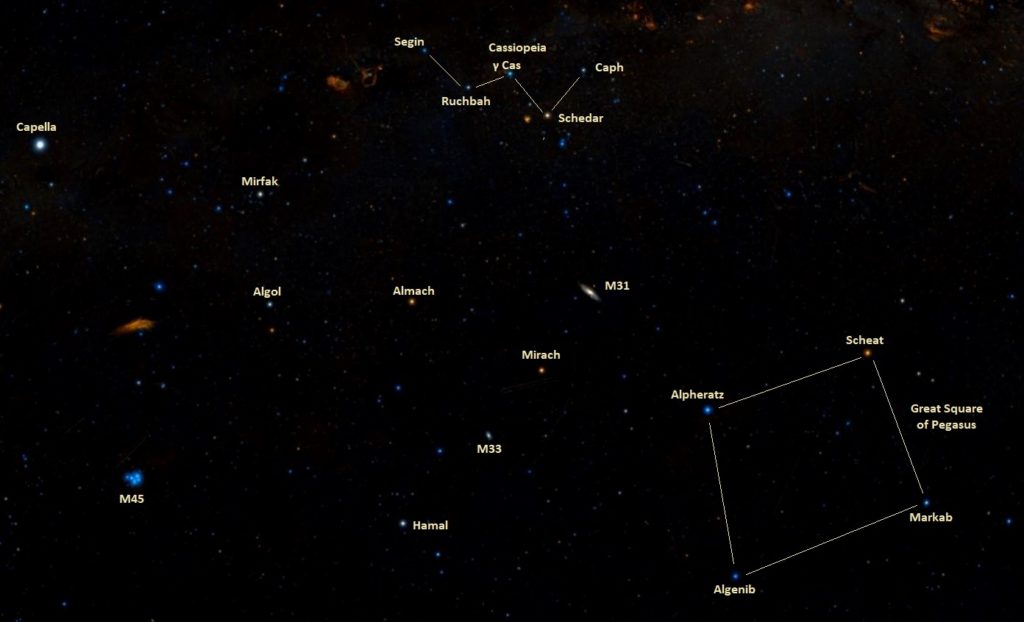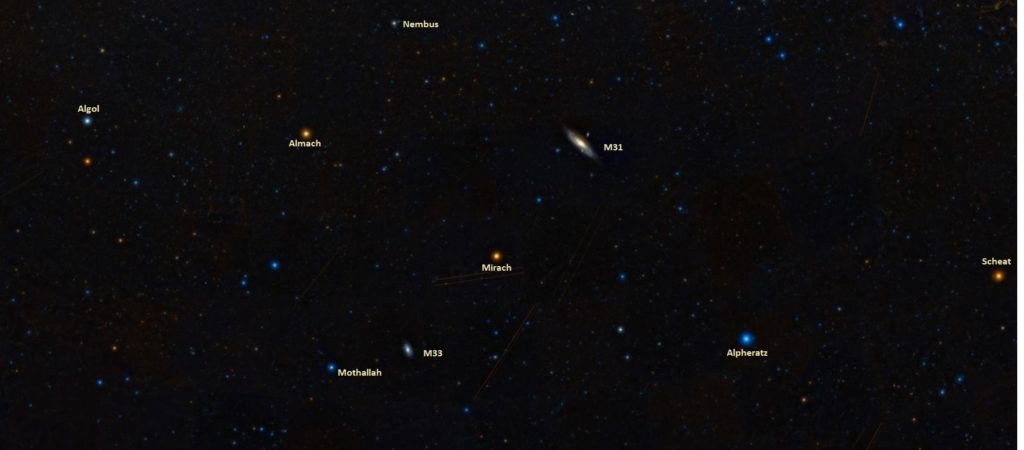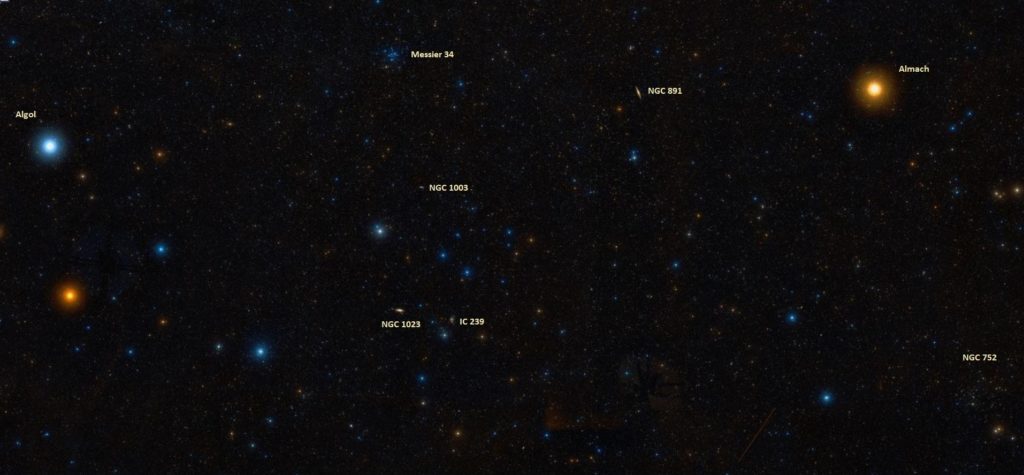Almach, Gamma Andromedae (γ And), is a quadruple star system located in the constellation Andromeda. With an apparent magnitude of 2.27, it is the third brightest point of light in Andromeda. It is only slightly fainter than Mirach and Alpheratz, the constellation’s brightest stars. Almach lies at an approximate distance of 350 light years from Earth. It is a popular target for stargazers because the main components form a striking contrasting pair, like Izar in Boötes and Albireo in Cygnus. The brighter component appears orange or yellow, while the dimmer one is bluish white.
Star system
Gamma Andromedae appears as a single star to the unaided eye but is in fact a multiple star system. The main components are designated Gamma1 Andromedae and Gamma2 Andromedae or Gamma Andromedae A and Gamma Andromedae BC. They appear as a contrasting pair separated by about 10 arcseconds.
Gamma2 Andromedae is itself a multiple star system consisting of a spectroscopic binary star system, Gamma Andromedae B, and a companion, Gamma Andromedae C. Gamma1 Andromedae and Gamma2 Andromedae orbit each other with a period of 4,748 years.
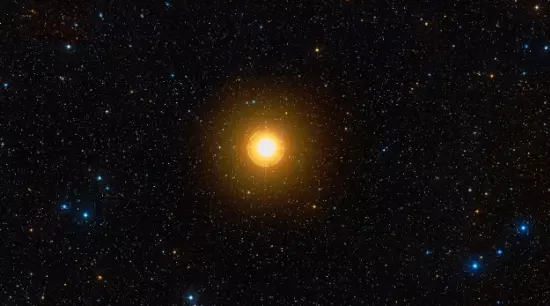
Almach (Gamma Andromedae), image: Wikisky
The primary component, formally named Almach (Gamma1 Andromedae), has the stellar classification K3IIb, indicating a bright giant star appearing orange in colour. The star has a radius 80 times that of the Sun. With a surface temperature of 4,500 K, it is 2,000 times more luminous than the Sun. It has a projected rotational velocity of up to 17 km/s.
Gamma2 Andromedae (Gamma Andromedae BC) is a triple star consisting of a spectroscopic binary system and a white main sequence star. The components have apparent magnitudes of 5.5 (Gamma Andromedae B) and 6.3 (Gamma Andromedae C). Their combined magnitude is 4.84. Gamma Andromedae BC is separated by about 9.6’’ from Gamma Andromedae A at a position angle of 63 degrees.
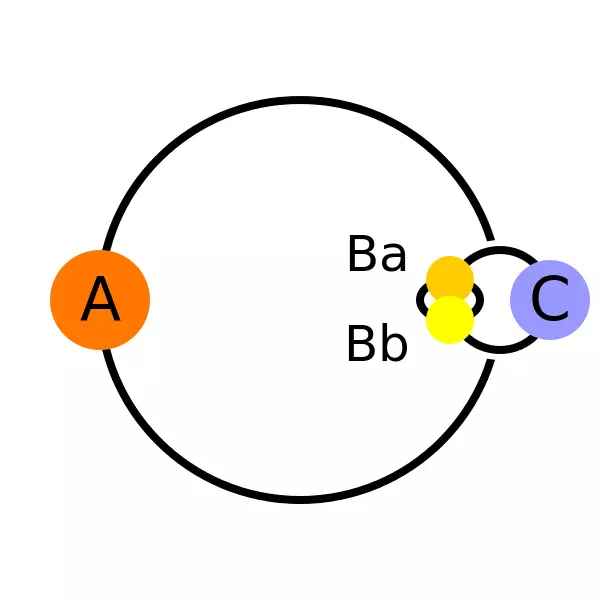
Gamma Andromedae system, image: Wikimedia Commons/Antonsusi
The spectroscopic binary system, Gamma Andromedae B, consists of two blue-white main sequence stars of the spectral type B9.5V. The system is closer to us than Gamma Andromedae A, lying at a distance of about 260 light years.
Gamma Andromedae B and Gamma Andromedae C orbit each other with a period of 63.67 years at an average separation of only 0.3 arcseconds (33 astronomical units).
Facts
The multiple nature of Gamma Andromedae was discovered by the German physicist and astronomer Johann Tobias Mayer in 1778. Mayer reported the star to be a double.
Gamma2 Andromedae was discovered to be a double by the German-Russian astronomer Wilhelm Struve in October 1842. Struve noted that the two components were separated by less than an arcsecond.
Spectrograms taken from October 1957 to February 1959 revealed that Gamma Andromedae B was itself a spectroscopic binary consisting of components of the spectral type B9.5V that orbit each other with a period of 2.67 days.
In Babylonian astronomy, Almach and the stars of Triangulum formed a constellation called MULAPIN (), “the Plough.” This was the first constellation presented on a pair of tablets known as the MUL.APIN. This was a Babylonian astronomical compendium that listed 66 stars and constellations, with notes on rising, setting, and culmination dates. The Babylonian compendium was named for its incipit (the opening words of the text), which corresponded to the first constellation of the year. In Mesopotamia, the Plough constellation’s heliacal rising (appearance in the sky before the dawn after a period of invisibility) in February marked the beginning of spring ploughing. The earliest copy of the MUL.APIN dates back to 686 BCE, but the text is believed to have been compiled around 1000 BCE.
Like many other bright stars, Almach has been used or mentioned in numerous works of fiction. The most memorable uses include the novels Uranie (1889) by Camille Flammarion, Isaac Asimov’s Foundation (1951), and Jack Vance’s The Five Gold Bands (1953).
Name
The name Almach (pronunciation: /ˈælmæk/) comes from the Arabic al-‘anāq, meaning “caracal (desert lynx).” It has also been spelled as Almak, Almaak, Alamak, Almaach and Almaack.
The name was officially approved by the International Astronomical Union’s (IAU) Working Group on Star Names (WGSN) on July 20, 2016. It formally applies only to the component Gamma Andromedae A (Gamma1 Andromedae).
In medieval Arabic astronomy, Almach was also known as Rijl al Musalsalah, meaning “the foot of the chained woman.” The name refers to the star’s position in the constellation Andromeda, marking Andromeda’s foot.
Egyptian astronomer Al Achsasi al Mouakket called the star Khamis al Naamet, “the fifth ostrich,” in his Calendarium, written around 1650. The name was translated into Latin as Quinta Struthionum. The other stars representing the ostriches were Eta Ceti (Prima Struthionum), Theta Ceti (Secunda Struthionum), Tau Ceti (Tertia Struthionum), and Baten Kaitos (Zeta Ceti, Quarta Struthionum). Upsilon Ceti was more commonly known as “the fifth ostrich” and it is unclear why Al Achsasi al Mouakket used the name for Almach instead.
The Chinese know Almach as 天大將軍一 (Tiān Dà Jiāng Jūn yī), the First Star of Heaven’s Great General. Heaven’s Great General is a Chinese asterism formed by Almach with Phi Persei, Nembus (51 Andromedae), 49 Andromedae, Chi Andromedae, Titawin (Upsilon Andromedae), Tau Andromedae, 56 Andromedae, Beta Trianguli, Gamma Trianguli, and Delta Trianguli. The asterism is part of the Bond mansion, which represents the body of the White Tiger.
Location
Almach is relatively easy to find because it is part of a chain of three bright stars between the Great Square of Pegasus and the constellation Perseus. The chain is formed by Alpheratz, the upper left star of the Great Square, Mirach, a reddish star of equal brightness, and Almach, which lies near the border with Perseus. Almach lies roughly along the imaginary line extended from Caph through Schedar, the stars on the right side of Cassiopeia’s W.
The chain of three bright stars is commonly used to find Mirfak, the brightest star in Perseus, and the famous variable star Algol. Mirfak, the central star of the Alpha Persei Cluster, is found by extending the line from Mirach to Almach in the direction of Perseus, and Algol forms a triangle with Mirfak and Almach.
Almach can also be used to find several interesting deep sky objects which lie in the region between the star and its neighbour Algol in Perseus. These include the bright open cluster Messier 34 (mag. 5.5), the edge-on unbarred spiral galaxy NGC 891, also known as the Silver Sliver Galaxy or the Outer Limits Galaxy (mag. 10.8), the spiral galaxy NGC 1003 (mag. 11.2), the barred lenticular galaxy NGC 1023 (mag. 10.35), and the spiral galaxy IC 239 (mag. 12.1).
The bright, large open cluster NGC 752 can be found about 5 degrees south and a little west of Almach. It has an apparent magnitude of 5.7 and lies 1,300 light years away.
Constellation
Almach is located in the constellation Andromeda. Representing the princess Andromeda from Greek mythology, the constellation stretches across 722 square degrees of the northern sky. It is the 19th largest of all 88 constellations. It lies near several other constellations associated with the myth of Perseus: Perseus, Cassiopeia, Cepheus, Pegasus and Cetus. Like these constellations, Andromeda is one of the 48 Greek constellations, first listed by Claudius Ptolemy in the 2nd century CE.
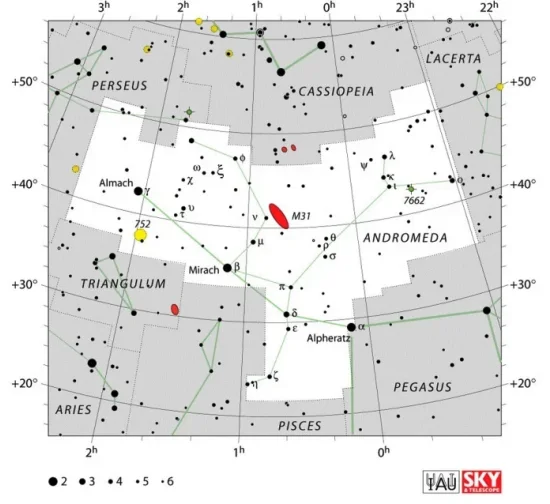
Andromeda constellation map by IAU and Sky&Telescope magazine
The constellation is best-known for being home to the Milky Way’s largest neighbour, the Andromeda Galaxy (Messier 31), and its two smaller satellites, Messier 32 and Messier 110. It also contains the magnitude 10.8 spiral galaxy NGC 891 (the Silver Sliver Galaxy), the planetary nebula catalogued as NGC 7662 and also known as the Blue Snowball Nebula, and the bright open star clusters NGC 752 and NGC 7686.
The best time of year to observe the stars and deep sky objects in Andromeda is during the month of November, when the constellation rises high in the evening sky.
The 10 brightest stars in Andromeda are Mirach (Beta And, mag. 2.05), Alpheratz (Alpha And, mag. 2.06), Almach (Gamma And, mag. 2.10), Delta Andromedae (mag. 3.28), Nembus (51 And, mag. 3.57), Omicron Andromedae (mag. 3.62), Lambda Andromedae (mag. 3.8), Mu Andromedae (mag. 3.87), Zeta Andromedae (mag. 4.08), and Titawin (Upsilon And, mag. 4.10).
Almach – Gamma Andromedae A
| Spectral class | K3IIb |
| U-B colour index | +1.58 |
| B-V colour index | +1.37 |
| R-I colour indeks | +0.68 |
| Apparent magnitude | 2.28 |
| Distance | 350 ± 30 light years (109 ± 9 parsecs) |
| Parallax | 9.19 ± 0.73 mas |
| Radial velocity | −11.7 ± 0.9 km/s |
| Proper motion | RA: 43.08 mas/yr |
| Dec.: −50.85 mas/yr | |
| Luminosity | 2,000 L☉ |
| Radius | 80 R☉ |
| Temperature | 4,500 K |
| Rotational velocity | < 17 km/s |
| Constellation | Andromeda |
| Right ascension (γ And A) | 02h 03m 53.9531s |
| Declination (γ And A) | +42° 19′ 47.009″ |
| Names and designations | Almach, Gamma1 Andromedae, γ1 And, Gamma Andromedae A, γ And A, 57 Andromedae A, HD 12533, HR 603, HIP 9640, FK5 73, SAO 37734, GC 2477, GCRV 1133, PPM 44721, BD+41 395, PLX 424, STF 205A, CCDM J02039+4220A, WDS 02039+4220A, IDS 01578+4151 A, ADS 1630 A, TYC 2837-2311-1 |
Gamma Andromedae BC
| Spectral class | B9.5V/B9.5V (B), A0V (C) |
| U-B colour index | −0.12 |
| B-V colour index | +0.03 |
| Apparent magnitude | 4.84 (5.5 + 6.3) |
| Distance (γ And B) | 260 ± 10 light years (80 ± 4 parsecs) |
| Parallax (γ And B) | 12.5653 ± 0.5881 mas |
| Radial velocity (γ And B) | −14.0 ± 5 km/s |
| Proper motion (γ And B) | RA: 30.021 mas/yr |
| Dec.: −51.640 mas/yr | |
| Right ascension | 02h 03m 54.7399980936s |
| Declination | +42° 19′ 51.336648306″ |
| Names and designations | Gamma2 Andromedae, γ2 And, Gamma Andromedae BC, γ And BC, 57 Andromedae BC, HD 12534, HR 604, SAO 37735, GC 2479, GCRV 1134, STT 38, STF 205BC, CCDM J02039+4220BC, WDS 02039+4220BC, IDS 01578+4151 BC, ADS 1630 BC, TYC 2837-2311-2, Gaia DR2 346231302441905920 |
